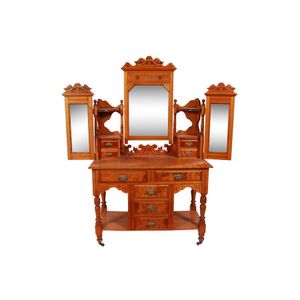
Royal Commemorative Miniature Chest by W.H. Rocke & Co
W.H. Rocke & Co. Two drawer miniature chest with Royal insignia brass handle plates, made to commemorate the visit of Duke and Duchess of Cornwall and York, late 19th century, stamped 'W.H. Rocke & Co., Melbourne', 24 cm high, 33 cm wide, 25 cm deep

Antique Cedar Duchess Chest Base
An antique Duchess chest base, Australian cedar with serpentine top drawer and well-figured lower drawers, 19th century, 93 cm high, 88 cm wide, 45 cm deep

Victorian Cedar Duchess Dressing Chest
A Victorian cedar duchess dressing chest, 155 cm high, 108 cm wide, 42 cm deep

Mottled Kauri Duchess with Carved Details and Jewelry Drawers
A colonial mottled kauri duchess, carved detail to mirror with conforming carved supports, four jewellery drawers, the base with two half and two full width drawers, raised on turned feet, later restoration. 108 x 50 x 190 cm.

Victorian Burr Walnut Duchess Dressing Table
A quality Victorian burr walnut Duchess dressing table, circa 1870, in solid walnut with burr walnut veneers, an oval mirror supported by finely, carved and pierced antlers above a pair of pillars each with three petite, drawers, a central hinged…

Mahogany Duchess Dressing Table with Fluted Columns
Victorian mahogany Duchess dressing table, the top with three small serpentine drawers, the base with long drawer, fluted column supports and concave under tier

Late Victorian Huon Pine Dressing Table with Folding Mirrors
A late Victorian dressing table in huon pine, Duchess type, shelf back, with folding side mirrors, and spandrel carvings, height 177 cm, length 107 cm, depth 52 cm

Victorian Mahogany Dressing Table with Oval Mirror
A Victorian dressing table, late 19th century, mahogany & cedar, central oval mirror back, six drawer Duchess top over, three drawer base

Victorian Mahogany Duchess Dressing Table - 176cm High
A Victorian mahogany duchess dressing table, 176 cm high, 120 cm wide, 54 cm deep

Federation Pine Duchess Dressing Table with Swing Mirror
A Federation pine duchess dressing table, four drawers to base and two jewellry drawers and a swing mirror 170 cm high, 90 cm wide, 45 cm deep

 Loading more...
Loading more...